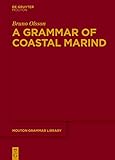A Grammar of Coastal Marind / Bruno Olsson.
Material type: TextSeries: Mouton Grammar Library [MGL] ; 87Publisher: Berlin ; Boston : De Gruyter Mouton, [2021]Copyright date: ©2021Description: 1 online resource (XXI, 587 p.)Content type:
TextSeries: Mouton Grammar Library [MGL] ; 87Publisher: Berlin ; Boston : De Gruyter Mouton, [2021]Copyright date: ©2021Description: 1 online resource (XXI, 587 p.)Content type: - 9783110725551
- 9783110747126
- 9783110747065
- 499/.12 23/eng/20230216
- online - DeGruyter
- Issued also in print.
| Item type | Current library | Call number | URL | Status | Notes | Barcode | |
|---|---|---|---|---|---|---|---|
 eBook
eBook
|
Biblioteca "Angelicum" Pont. Univ. S.Tommaso d'Aquino Nuvola online | online - DeGruyter (Browse shelf(Opens below)) | Online access | Not for loan (Accesso limitato) | Accesso per gli utenti autorizzati / Access for authorized users | (dgr)9783110747065 |
Browsing Biblioteca "Angelicum" Pont. Univ. S.Tommaso d'Aquino shelves, Shelving location: Nuvola online Close shelf browser (Hides shelf browser)

|

|

|

|

|

|

|
||
| online - DeGruyter LINDA BERGER – PEACH-BLOW : MONOGRAFIE/MONOGRAPH / | online - DeGruyter Cherilo di Iaso : Testimonianze, frammenti, fortuna / | online - DeGruyter A Grammar of Kunbarlang / | online - DeGruyter A Grammar of Coastal Marind / | online - DeGruyter Herbartism in Austrian Philosophy / | online - DeGruyter Complementary Democracy : The Art of Deliberative Listening / | online - DeGruyter Conciliation in the Qurʾan : The Qurʾanic Ethics of Conflict Resolution / |
Frontmatter -- Acknowledgements -- Contents -- List of maps, tables and figures -- Abbreviations and conventions -- 1 Preliminaries -- 2 Phonology -- 3 Nominals, their morphology and derivation -- 4 Pronouns and demonstratives -- 5 Nominal gender -- 6 Adpositions and particles -- 7 The syntax of phrases -- 8 Overview of the verb -- 9 Participant indexing I: The Actor, Dative and Genitive prefixes -- 10 Participant indexing II: Undergoer alternations -- 11 The system of Verb Orientation -- 12 Valence classes -- 13 Valence-changing constructions -- 14 Tense and aspect -- 15 Mood, attitude and engagement -- 16 Distribution of events in time and space -- 17 The Auxiliary, copula clauses and light verbs -- 18 Basic clausal syntax -- 19 Non-declarative speech acts -- 20 Combinations of clauses -- Appendix: Texts -- Bibliography -- Index
restricted access online access with authorization star
http://purl.org/coar/access_right/c_16ec
This grammar provides the first modern, comprehensive description of Coastal Marind. It is a Papuan language spoken by the coastal-dwelling Marind-Anim, formerly expansionistic head-hunters of the Southern New Guinea lowlands. Like the other languages of the poorly known Anim family, Coastal Marind features astonishingly complex verb morphology and a range of unusual phenomena, including indexing of up to four arguments on the verb, verbal marking of focus (the 'Orientation' system), engagement prefixes tracking the attention of the addressee, and a system of four genders realised by intricate agreement patterns. The structure of the language is examined in a detailed but accessible way, and its many complexities are brought to life by contextualised spontaneous data, drawn from a rich audio-visual corpus.
Issued also in print.
Mode of access: Internet via World Wide Web.
In English.
Description based on online resource; title from PDF title page (publisher's Web site, viewed 25. Jun 2024)


